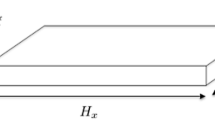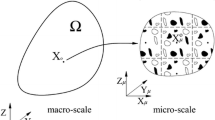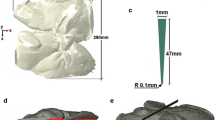Abstract
In this paper we develop the point collocation-based method of finite spheres (PCMFS) to simulate the viscoelastic response of soft biological tissues and evaluate the effectiveness of model order reduction methods such as modal truncation (MT), Hankel optimal model and truncated balanced realization (TBR) techniques for PCMFS. The PCMFS is a physics-based meshfree numerical technique for real time simulation of surgical procedures. Since computational speed has a significant role in simulation of surgical procedures, model order reduction methods have been compared for relative gains in efficiency and computational accuracy. Of these methods, TBR results in the highest accuracy with an average error which is within 3.37% of the full model while MT results in the highest efficiency with a computational cost reduction of 54.2% compared to the full model.












Similar content being viewed by others
References
Basdogan C, De S, Kim J, Manivannan M, Srinivasan MA (2004) The role of haptics in medical simulations. IEEE Comput Graph Appl 24(2):56–64
Mack MJ (2001) Minimally invasive and robotic surgery. JAMA 192:2355–2375
Lim YJ, De S (2007) Real time simulation of nonlinear tissue response in virtual surgery using the point collocation-based method of finite spheres. Comput Methods Appl Mech Eng 196:3011–3024
De S, Lim Y, Manivannan M, Srinivasan MA (2006) Physically realistic virtual surgery using the point-associated finite field (PCMFS) approach. Presence: Teleoper. Virtual Environ 15(3):294–308
De S, Bathe KJ (2001) Towards an efficient meshless computational technique: the method of finite spheres. Eng Comput 18:170–192
Debunne G, Desbrun M, Cani M, Barr AH (2001) Dynamic real-time deformations using space & time adaptive sampling. In Proceedings of the 28th Annual Conference on Computer Graphics and interactive Techniques SIGGRAPH ‘01. ACM Press, New York, pp 31–36
Hauth M, Groß J, Straßer W (2003) Interactive physically based solid dynamics. In Proceedings of the 2003 ACM Siggraph/Eurographics Symposium on Computer Animation (San Diego, California, July 26–27, 2003). Symposium on Computer Animation. Eurographics Association, Aire-la-Ville, Switzerland, 17–27
Sedef M, Samur E, Basdogan C (2006) Real-Time Finite-Element Simulation of Linear Viscoelastic Tissue Behavior Based on Experimental Data. IEEE Comput Graph Appl 26(6):58–68
Schoner JL, Lang J, Seidel HP (2004) Measurement-Based Interactive Simulation of Viscoelastic Solids. Comput Graph Forum 23(3):547–556
Schwartz JM, Denninger M, Rancourt D, Moisan C, Laurendeau D (2005) Modeling liver tissue properties using a non-linear visco-elastic model for surgery simulation. Med Image Anal 9(2):103–1127
Antoulas AC (2005) Approximation of large-scale dynamical systems, Society for Industrial and Applied Mathematic (SIAM)
Freund RW (2000) Krylov-subspace methods for reduced-order modeling in circuit simulation. J Comput Appl Math 123(1–2):395–421
Rudnyi EB, Korvink JG (2002) Review: Automatic Model Reduction for Transient Simulation of MEMS-based Devices. Sens Update 11(1):3–33
Feldmann P, Freund RW (1994) Efficient linear circuit analysis by Pade′ approximation via the Lanczos process. In Proceedings of the Conference on European Design Automation (Grenoble, France). European Design Automation Conference. IEEE Computer Society Press, Los Alamitos, CA, 170–175
Freund RW, Feldmann P (1996) Reduced-order modeling of large passive linear circuits by means of the SYPVL algorithm. In Proceedings of the 1996 IEEE/ACM international Conference on Computer-Aided Design (San Jose, California, United States, November 10–14, 1996). International Conference on Computer Aided Design. IEEE Computer Society, Washington, DC, pp 280–287
Kamon M, Wang F, White J (2000) Generating nearly optimally compact models from krylov-subspace based reduced-order models. IEEE Trans Circuits Syst-II Analog Digit Signal Process 47(4):239–248
Moore B (1981) Principal component analysis in linear systems controllability, observability and model reduction. IEEE Trans Automat Control 26(1):17–32
Penzl T (1998) Numerical solution of generalized Lyapunov equations. Adv Comput Math 8(1):33–48
Tombs MS, Postlethwaite I (1987) Truncated balanced realization of a stable nonminimal state space system. Int J Control 46(4):1319–1330
Li JR (2000) Model Reduction of Large Linear Systems via Low Rank System Gramians, PhD thesis
Simo JC, Hughes TJR (2004) Computational inelasticity. Springer, Berlin
Taylor RL, Pister KS, Goudreau GL (1970) Thermomechanical analysis of viscoelastic solids. Int J Numer Methods Eng 2(1):45–59
Bathe KJ (1996) Finite Element Procedures. Prentice-Hall, Englewood Cliffs
Zienkiewicz OC, Taylor RL (2005) The finite element method set, 6th edn. Butterworth-Heinemann
Skgestal S, Postlethwaite I (1996) Multivariable feedback control, analysis and design. Wiley, NY
Zhou K, Doyle J, Glover K (1995) Robust and optimal control. Prentice Hall, Englewood Cliffs
Author information
Authors and Affiliations
Corresponding author
Rights and permissions
About this article
Cite this article
BaniHani, S.M., De, S. A comparison of some model order reduction methods for fast simulation of soft tissue response using the point collocation-based method of finite spheres. Engineering with Computers 25, 37–47 (2009). https://doi.org/10.1007/s00366-008-0103-4
Received:
Accepted:
Published:
Issue Date:
DOI: https://doi.org/10.1007/s00366-008-0103-4




